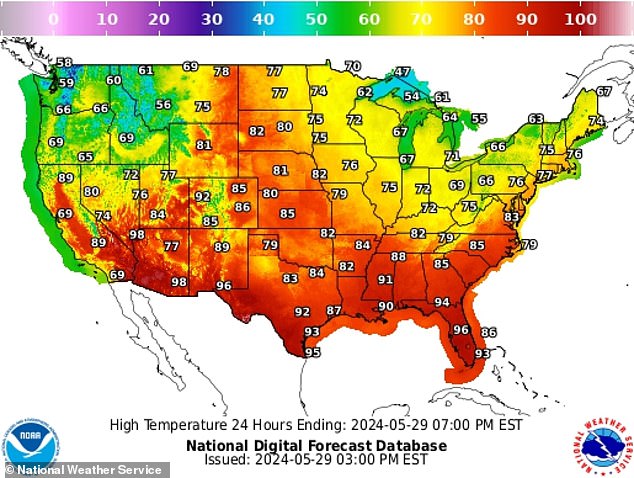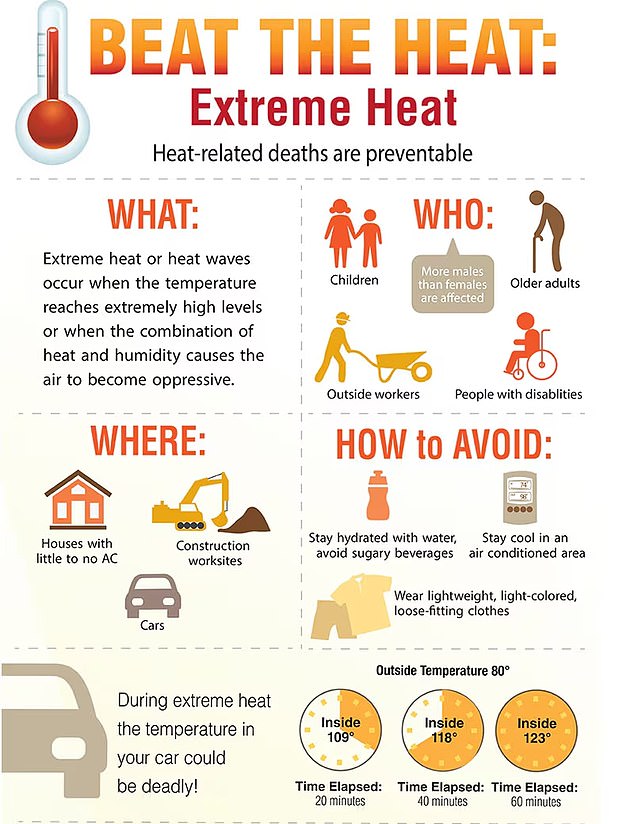Deadly ‘heat dome’ weather event scorches parts of US this WEEK with temperatures up to 111F – these are the cities most at risk
An extreme heat wave is coming from Mexico to the US and experts warn that 7.7 million people in the hotspots could be affected.
Florida, Texas and parts of Nevada will be hit by the expanding “heat dome,” with temperatures expected to rise to dangerous levels of more than 110 degrees Fahrenheit.
Rising temperatures have already begun fueling intense thunderstorms in Houston and Dallas, Texas, over the past two weeks, reaching a record-breaking 115 degrees Fahrenheit on Memorial Day — breaking the previous record of 108 degrees set in May 1998.
The ‘heat dome’ that has spread across Mexico since March has already claimed the lives of more than 20 people and killed 157 endangered howler monkeys.
16 US cities will be hit with extreme temperatures over 90 degrees Fahrenheit. This is the starting point for dehydration and heat stroke

The Southwest will experience the nation’s most intense heat waves, with temperatures reaching 111 degrees Fahrenheit early next week in Corpus Christi week and nearly 100 in Dallas
The National Weather Service’s Climate Prediction Center has issued a warning that much of the Southwest will be affected by the heat dome, pushing temperatures to more than 90 degrees Fahrenheit.
The state accounts for six of the top 16 U.S. cities that will see the hottest days, with temperatures reaching 111 degrees Fahrenheit early next week in Corpus Christi week and nearly 100 in Dallas.
This is about 10 to 15 degrees higher than the state average a decade ago.
Residents of other cities, including Tampa and Miami, Florida, Phoenix, Arizona and New Orleans, Louisiana, should prepare by making sure their homes are fully stocked with water and that they have access to air conditioning.
A heat dome is created when hot sea air becomes trapped in the atmosphere, much like putting a lid on a boiling pot.
The hot air expands through the atmosphere, creating a dome-like structure that prevents cooler air from circulating, blocks clouds and rain, and can increase the risk of wildfires.
“We’re basically just letting the sun stream down unhindered, burning the ground, and there’s no real cloud cover or moisture to prevent our temperatures from rising,” Gabriel A. Vecchi, a professor of geosciences at Princeton University, told me. TIME.

The CDC reported that there are steps you can take to protect yourself from heat-related illnesses, including staying hydrated as much as possible and staying in air-conditioned spaces

Florida, Texas and parts of Nevada will be hit by an expanding “heat dome,” with temperatures expected to rise to dangerous levels of more than 110 degrees Fahrenheit
As the heat domes expel rain, all moisture is forced to move up and over the bubble, creating so-called “ring of fire” thunderstorms that have occurred in parts of Texas.
Extreme heat kills more people in the US than any other weather pattern, causing the deaths of 1,220 Americans every year, according to US statistics. Center for Disease Control and Prevention.
It only takes 10 to 15 minutes for your body to overheat, and if it can’t cool down immediately, it can lead to muscle cramps or spasms, dizziness, nausea and vomiting, headaches and death.
The extreme heat is expected to continue from June through August and experts are concerned it will contribute to a higher risk of tropical cyclones this summer.
Experts are concerned that the heat dome will also cause major droughts after affecting 80 percent of southern Mexico, where temperatures reached 118 degrees Fahrenheit.
It has caused lakes and dams to dry up and water supplies to be depleted, prompting protests from Mexico City police officers who said their barracks had no water for a week and bathrooms were unusable.
The extreme heat is caused by greenhouse gases from the combustion of fossil fuels such as oil, gas and coal.
“We can expect another dangerously hot summer season, with parts of Texas and Florida already breaking daily records,” said Kristy Dahl, chief climate scientist for the Union of Concerned Scientists’ Climate and Energy program. The guard.
“As we warm the planet, we will see climate disasters compound and reinforce each other due to the lack of resilience in our infrastructure and government systems.”
In response to increasing heat waves, the National Oceanic and Atmospheric Administration (NOAA) has a seven-day… heat risk prediction so that Americans can stay informed about the consequences they will experience.
